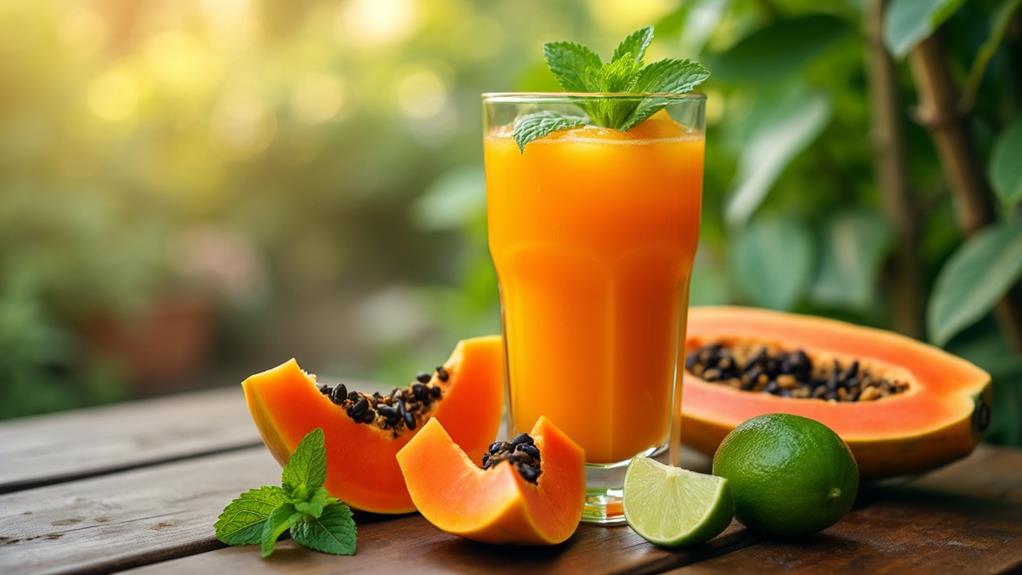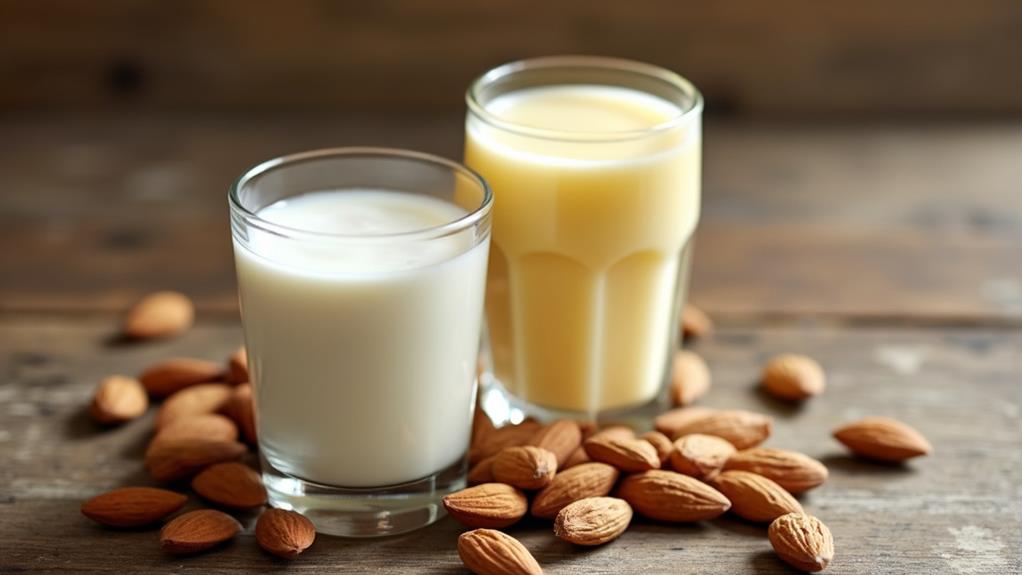Mulberry Juice: Sweet, Tangy, and Full of Antioxidants
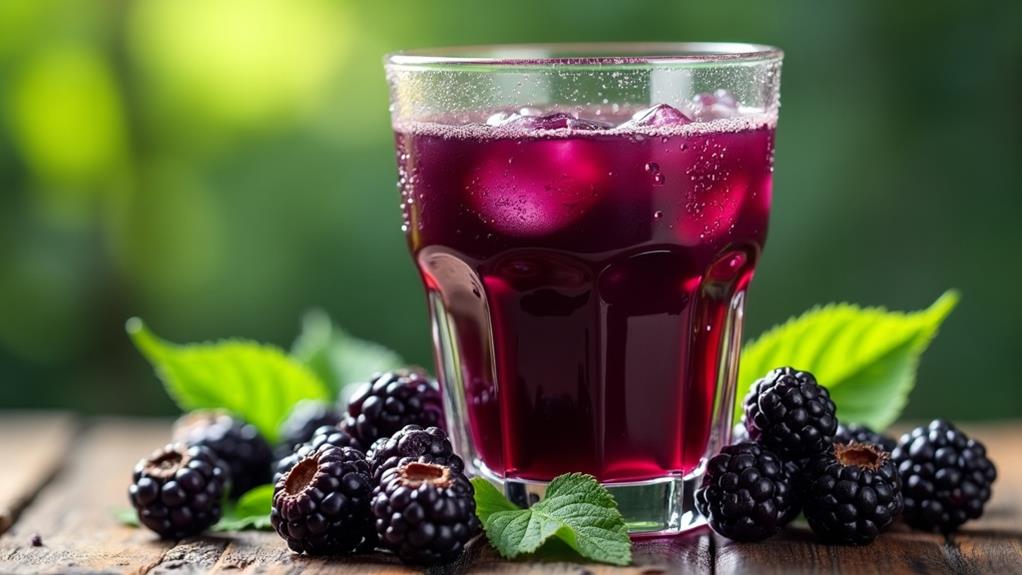
Mulberry juice delivers a distinctly sweet and tangy taste packed with antioxidants, like anthocyanins and resveratrol, to help combat oxidative stress. It's low in calories and rich in vitamin C, making it a great choice for the health-conscious. Enjoy its heart health benefits, potential cholesterol-lowering effects, and its ability to improve your immune system. You can add this juice to smoothies, make delicious homemade jams, or even use it in salad dressings. Remember, moderation is key, as too much might cause digestive discomfort. For more insights into its cultural importance and culinary uses, the expedition has just begun.
Types of Mulberries
When exploring the diverse world of mulberries, you'll find that each type offers unique characteristics and advantages. The White Mulberry, or Morus alba, is well-known not just for its role in feeding silkworms, but also for its delicate fruit, which comes in shades of white to light purple. It's one of the more commonly grown varieties, especially in areas tied to silk production.
On the other hand, the Red Mulberry, or Morus rubra, thrives with its robust nature, easily grafted and capable of withstanding harsh weather. Its fruit displays lively red to purple hues, making it a favorite for those living in regions with challenging climates.
The Black Mulberry, or Morus nigra, is famed in Asia for its rich, sweet flavor, albeit it requires more care to cultivate. Its fruits, deep purple to black, are worth the extra effort for their taste alone. Meanwhile, the Himalayan Mulberry, thriving in colder, mountainous areas, offers a unique resilience and distinct flavor profile suitable for those climates. Finally, the Dwarf Mulberry, or Morus microphylla, is perfect for compact gardens, providing colorful fruit without the need for extensive space. Each type offers diverse fruit colors and flavors, enhancing your mulberry experience.
Nutritional Profile
Mulberry juice is a powerhouse of nutrition, offering a low-calorie option with only about 43 calories per 100 grams of fruit. It's an excellent choice if you're looking to enjoy a tasty beverage without packing on the calories. Rich in antioxidants like anthocyanins and resveratrol, mulberry juice boasts impressive health-promoting properties that help combat oxidative stress. You'll find that this juice is not just delicious but also packed with nutritional value.
One of the standout features of mulberry juice is its high Vitamin C content, providing about 10% of your daily recommended intake per serving. This vitamin plays a significant role in supporting your immune function, keeping you healthy and resilient. Moreover, mulberry juice contains important minerals such as iron, potassium, and manganese. These minerals are critical for multiple metabolic processes, ensuring your body runs smoothly and efficiently.
Furthermore, mulberry juice is high in dietary fiber, which promotes digestive health and helps you feel fuller longer. This can be particularly beneficial for weight management, as it reduces the temptation to overeat. So, enjoy the sweet, tangy goodness of mulberry juice while reaping its numerous nutritional benefits!
Health Benefits
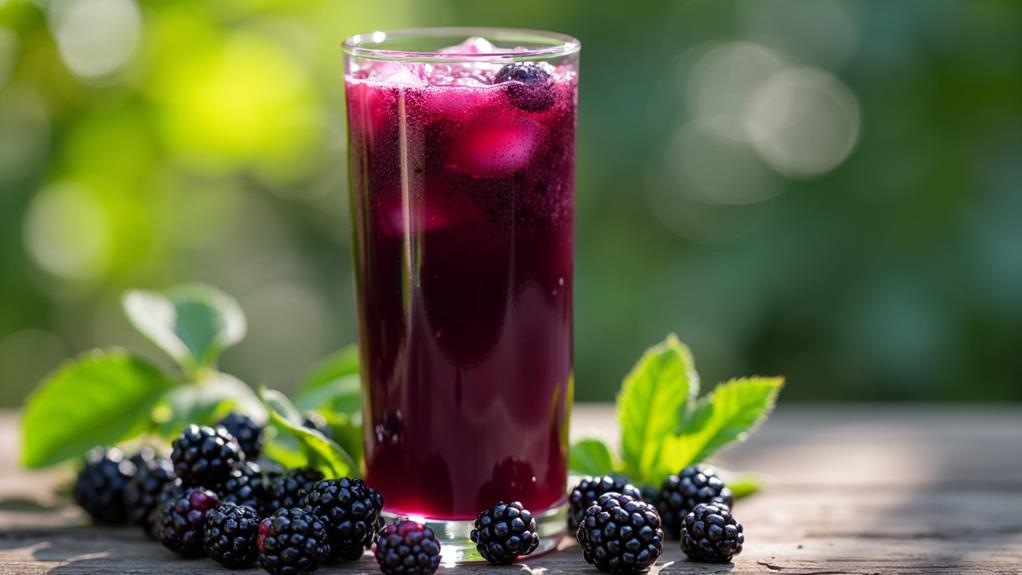
With its rich array of antioxidants, mulberry juice provides significant health benefits that can't be overlooked. The potent antioxidants, especially resveratrol, help combat oxidative stress, potentially reducing your risk of chronic diseases. By incorporating mulberry juice into your routine, you can support your heart health. It may lower cholesterol levels and improve comprehensive cardiovascular function, making it a smart choice for maintaining a healthy heart.
Mulberry juice is packed with vitamin C, enhancing your immune system and contributing to lively skin. It also contains vitamin K, which plays a crucial role in immune function and skin health. If you're concerned about blood sugar management, mulberry juice can be advantageous. It helps stabilize glucose levels, making it a suitable option for those with diabetes or anyone wanting to keep their blood sugar in check.
Rich in dietary fiber, mulberry juice supports digestive health by aiding digestion and promoting a feeling of fullness, which can assist in weight management. With its myriad of benefits, including supporting immune and digestive health and lowering cholesterol, mulberry juice is a delicious and healthful supplement to your diet.
Culinary Uses
Investigate the culinary versatility of mulberry juice, and you'll uncover a myriad of ways to improve your dishes. Start with its lively addition to smoothies, where mulberries not only amplify flavor but also augment nutritional value with their rich antioxidant content. The juice's natural sweetness makes it an ideal base for homemade jams and jellies, requiring minimal added sugars while delivering a flavorful punch.
Incorporating mulberry juice into salad dressings introduces a unique sweet-tangy flavor that complements fresh greens and nuts beautifully. Just a splash can raise your salad to a gourmet experience. Mulberry juice also shines in health drinks, often mixed with other fruit juices or herbal teas, providing immune support and promoting overall wellness.
Desserts are another playground for mulberry juice. Think sorbets, ice creams, and baked goods that not only benefit from its lively color but also from its distinct taste. Imagine a mulberry-infused sorbet on a hot summer day or a swirl of this delectable juice in your favorite cake batter. By embracing the culinary uses of mulberry juice, you're not just augmenting flavors but also infusing your meals with nature's antioxidant-rich goodness.
Growing and Harvesting
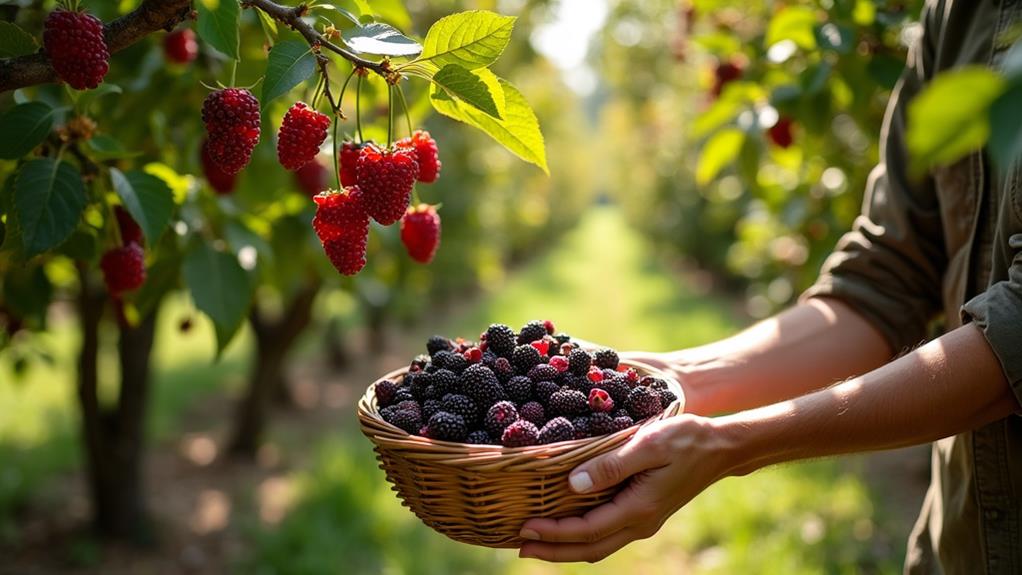
As you explore the culinary delights of mulberry juice, understanding how to grow and harvest these berries will enrich your appreciation for this versatile ingredient. Mulberry trees thrive best in well-drained soil and need full sunlight to flourish. Once established, they become drought-resistant, requiring only moderate watering. To optimize your fruit yield, regular pruning after the fruit has shed is essential. This process improves tree health by enhancing airflow and allowing more sunlight to penetrate, promoting vigorous growth.
Harvesting mulberries usually takes place from late spring to early summer, typically between March and May. During this period, the berries become ripe and are easily plucked from the branches. Keeping an eye on the ripeness guarantees you pick them at their peak for the sweetest, most flavorful juice. These trees can be propagated using seeds or cuttings, offering you the opportunity to expand your mulberry orchard as you wish.
With proper care, mulberry trees can live for several decades, making them a rewarding, long-term investment. By cultivating and maintaining these trees, you're providing a steady supply of delicious mulberries and a deeper connection to the natural process behind your favorite juice.
Historical Significance
Mulberry trees have woven their way through history, playing essential roles in cultural, economic, and medicinal contexts. Native to China, these plants have been important since ancient times, primarily cultivated for silkworm feed, hence fueling the silk industry. Their significance extends beyond economics; they're deeply rooted in cultural narratives, like the nursery rhyme "Here We Go Round the Mulberry Bush," reflecting their widespread presence.
In traditional medicine, both the leaves and fruits of mulberry trees have been invaluable. They've been used to improve blood circulation and general health, showcasing their antioxidant-rich properties. These uses underscore their importance across diverse cultures. For centuries, mulberries have been more than just food; they've been a remedy, a symbol of wellness and vigor.
King James I recognized the potential of mulberries, attempting to establish them in 17th-century England to enhance the silk industry. Although his efforts didn't succeed, they highlight the plant's perceived value. Furthermore, mulberry trees find their place in literature, such as the tale of Pyramus and Thisbe, symbolizing enduring love and tragedy. Their historical significance remains a reflection of their lasting influence on human culture and health.
Potential Risks
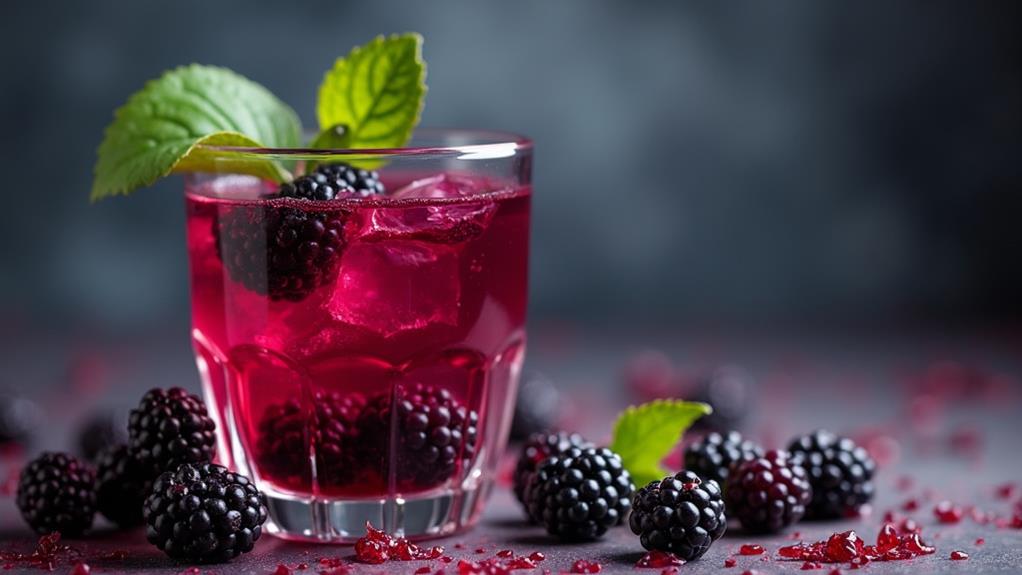
While mulberry juice boasts numerous health benefits, it's vital to be aware of its potential risks. Consuming it in excessive amounts can lead to gastrointestinal discomfort due to its high fiber content. If you're prone to digestive issues, moderation is key. Furthermore, people with a sensitivity to birch pollen should exercise caution, as allergic reactions may occur from cross-reactivity when drinking mulberry juice.
The natural sugars present in mulberry juice can also pose a risk. In susceptible individuals, excessive consumption may lead to hypoglycemia, especially if you're already managing blood sugar levels. This is particularly significant for those on diabetes medication, as mulberry juice might interact with these drugs, potentially affecting your health negatively.
If you're pregnant or breastfeeding, it's prudent to consult your healthcare provider before adding mulberry juice to your diet. Limited research exists on its safety during these periods, so professional guidance is vital. Despite being rich in antioxidants, which are generally beneficial, the potential risks of mulberry juice shouldn't be overlooked. Always consider how it fits into your complete health plan to guarantee you're reaping its benefits safely.
Buying and Storing
When you're buying mulberry juice, prioritize cold-pressed or organic options to enhance nutrient retention and minimize added sugars or preservatives. You can find fresh mulberry juice at local farmers' markets during the harvest season, from late spring to early summer. For more convenience, bottled mulberry juice is available year-round at health food stores and online. Always check the expiration date and storage instructions on these bottles to guarantee you're getting the best quality.
Once opened, store mulberry juice in the refrigerator in a tightly sealed container to maintain freshness and prevent spoilage. It's best to consume it within 5-7 days to enjoy peak taste and nutrient quality, including its rich antioxidants. If you want to extend the shelf life, consider freezing the juice in ice cube trays. This method allows you to use smaller portions as needed while preserving its beneficial properties.
Before consuming, always inspect the juice for signs of spoilage, such as off-smells or discoloration. Following these guidelines will help you enjoy the sweet and tangy benefits of mulberry juice while safeguarding its freshness and nutritional value.

